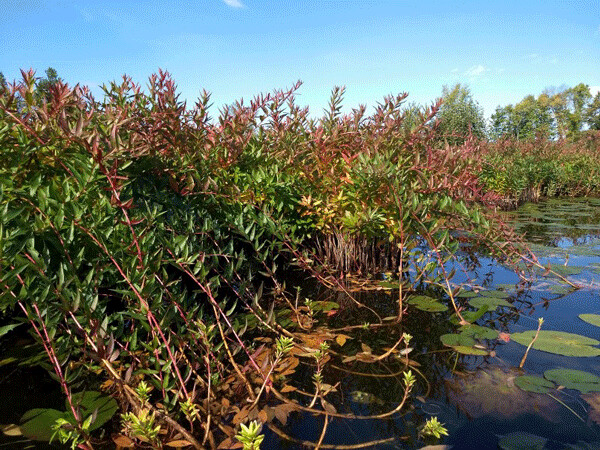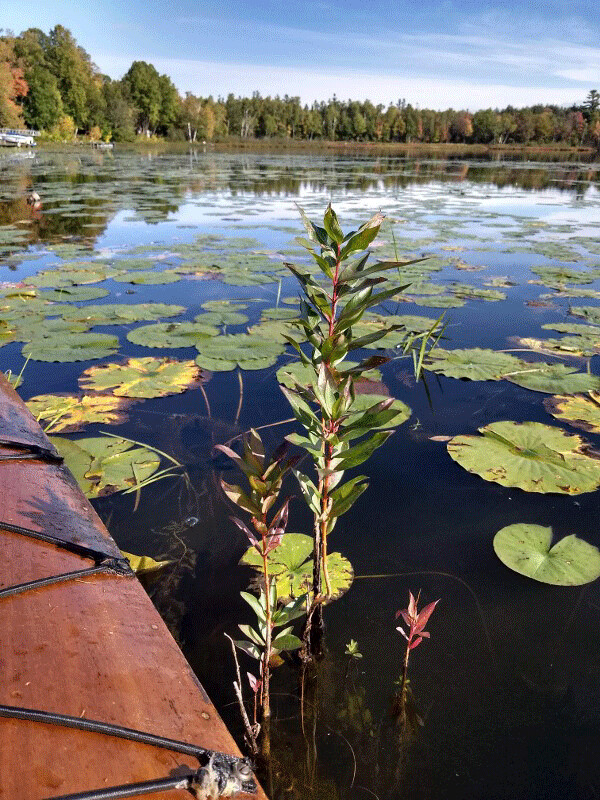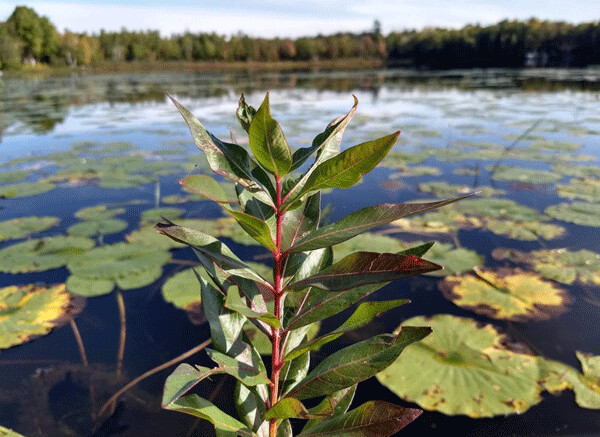Seek and You Shall Find

The cloud ceiling was low and gray, but at least it wasn’t raining, and it wasn’t cold. Earlier in the day, a couple from southern Wisconsin had stopped by the Museum to ask where they could see some loons without a boat. I’d directed them to Country Road D, which snakes along the eastern shore of Lake Namakagon, and now I hopped on my bike to follow my own advice.
No loons bobbed in the first bay, but as I surveyed the scenery, something else caught my attention. Almost the entire shoreline was striped with a band of plants turning a rich pink color for fall. Cattail and bur-reed leaves were still green. The floating, Packman-shaped leaves of water lilies were showing patches of yellow. The pickerel weed was crinkled and brown. But what could be pink? I rubbernecked on my bike, trying to make out the shapes of the leaves, going through the files of aquatic plants in my brain—and came up blank.
What could this be? And should it be there?
Those questions niggled at the back of my mind for several days, until finally a rare bit of calm sunshine sent me digging for my sunglasses and hauling my kayak down to the shore. It took a while to reach that pink-lined bay, but of course I enjoyed the journey. This new-to-me wooden sea kayak cut silently through the waves, and turned responsively when I leaned to one side or the other.

Through the lily pads, the kayak became more sluggish and noisy, but finally I reached the old beaver lodge, where clumps of the pink plant spread out into the shallow water.
The clusters were composed of dozens to hundreds of unbranched stems reaching upright in the center and spilling gracefully out over the water like a cascading bouquet. The lower leaves were still green, but the stems themselves, as well as the highest leaves in each cluster, were that vibrant shade of fuchsia I’d spotted from the shore.
Each leaf was lanceolate in shape, and maybe 5 inches long. The leaves clustered in whorls, with one tapered end attaching near two others on the stem, and the other point leaning outward and upward. Smooth edges, a waxy surface, and pink veins completed the look, but still did not call up a name from the lists I keep tucked away in the cobwebby recesses of my brain.
So, I extricated my phone from its waterproof case, and snapped a few photos to take home and identify later. Then I noticed that I was getting full reception—including data—way out here in the middle of nowhere. Just for kicks, I tapped the icon for the new “Seek” app I’d recently downloaded.
When I turned on the app’s camera, a live video popped up on the screen, and I began filming the plant from all angles. Words popped up on the screen, overlaying the images. “Dicots,” it said, as I tapped the screen to tell the camera where to focus. Dicots are a group that includes most plants, so that wasn’t helpful. Suddenly, “Swamp Loosestrife Decodon verticillatus” popped onto the screen. Success!

“Seek” is an educational tool built on iNaturalist—a website I’ve mentioned before. As citizen scientists upload and identify photos on the iNaturalist website, its computer vision system builds a model of each organism. Seek then uses those models to identify things in real-time. When I’d first learned about Seek from a friend in Milwaukee, I scoffed at the idea of ever having access to the cell phone data that would make it useful while in the middle of the woods. But here, in the middle of a lake, in the middle of nowhere, it worked.
Now, knowing that the plant was a loosestrife, the obvious next question that popped up was its relation to the non-native invasive purple loosestrife that most people know about. So I scrolled down in the species account, and quickly found that it is “native to wetlands in the eastern half of the United States and Canada.” Phew! Curiously, back at the office, when I checked the Wisconsin State Herbarium’s website, swamp loosestrife is not listed from Bayfield County. Is it a new arrival? Or just in an un-surveyed area? I posted my observation to iNaturalist, so as soon as someone else confirms my ID, it will be “research grade.” The next step may be creating an herbarium specimen of the plant in flower, so that it can be documented in a museum the old fashioned way.
You may be scoffing—just as I first did—at an app that plays into all the stereotypes about young people on their phones needing instant gratification. But, at least in this case, the final ID was just one piece of a multi-day journey. I biked, I paddled.
I wracked my brain for previous knowledge. It just so happens that Seek has a much bigger database, and a quicker search and retrieval system than my own busy brain. It’s not perfect, though. Playing around with the app later, I discovered with smug satisfaction that it still isn’t good enough to identify a sugar maple leaf. But I’m now able to recognize swamp loosestrife. I win!
Emily’s second book, Natural Connections: Dreaming of an Elfin Skimmer, is now available to purchase at www.cablemuseum.org/books and at your local independent bookstore, too.
For more than 50 years, the Cable Natural History Museum has served to connect you to the Northwoods. Come visit us in Cable, WI! Our new Curiosity Center kids’ exhibit and Pollinator Power annual exhibit are now open! Call us at 715-798-3890 or email emily@cablemuseum.org.
